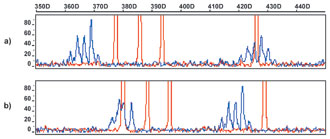


MOLECULAR ANALYSIS OF HUNTINGTON’S
DISEASE IN THE REPUBLIC OF MACEDONIA
Koceva S1,2, Dimovski AJ1, Plaseska-Karanfiska D1,
Stefanovska A-M1, Vlaski-Jekic S3, Efremov GD1,*
*Corresponding Author: Professor Dr. Georgi D. Efremov, Macedonian Academy of Sciences and Arts, Research Center for Genetic Engineering and Biotechnology, Aven Krste Misirkov 2, POB 428, 1000 Skopje, Republic of Macedonia; Tel: +3892-120253; Fax: +3892-115434; E-mail: gde@manu.edu
page: 47
|
|
RESULTS AND DISCUSSION
In this paper we describe the molecular analysis of HD in patients from the Republic of Macedonia. A total of 10 individuals were referred for analysis of the CAG expansion in the IT15 gene which is responsible for HD; seven presented with symptoms consistent with the clinical diagnosis of HD, while three required pre-symtomatic testing due to a family history of the disease. The study was conducted with two different methods, non radioactive PCR-PAGE and fluorescent PCR-capillary electrophoresis assay. Similar results were obtained with both methods, making the automated fluorescent PCR/capillary electrophoresis a method of choice for routine HD testing due to its speed, simplicity and reliability.
Expanded alleles (42 to 46 repeats) were detected in eight subjects, six out of seven patients with signs of the disease, and two asymptomatic individuals (Table 1). Two normal alleles were detected (range 15 to 26 repeats) in one patient and in one asymptomatic individual, which excluded the presence of HD. The frequency of the HD CAG trinucleotide repeats in our patients is in correlation with the results reported in a large worldwide study [12]. The patient with two normal alleles was a 12-year-old boy who was referred for analysis due to choreic movement and rigidity, and positive family history of the disease (his mother died at the age of 40 years with clinical symptoms consistent with the presence of HD). For the HD gene, the vast majority of normal people have <29 repeats (99%), whereas individuals diagnosed with HD have been shown to have 36 or more repeats. Intermediate alleles have been molecularly defined as CAG alleles from which new mutations have been shown to arise, and are greater in size than those usually seen in the general population (>28) [8,12]. The presence of the two normal alleles (17 and 22) in the HD gene excluded the presence of HD.

Figure 2. Automated fluorescent PCR-capillary electrophoresis analysis of (CAG)n repeat in two patients with HD. The blue zones are from fluorescent PCR fragments, while the red zones are from ROX labelled size standards. The sizes of each allele are also given.
|
|
|
|



 |
Number 27
VOL. 27 (2), 2024 |
Number 27
VOL. 27 (1), 2024 |
Number 26
Number 26 VOL. 26(2), 2023 All in one |
Number 26
VOL. 26(2), 2023 |
Number 26
VOL. 26, 2023 Supplement |
Number 26
VOL. 26(1), 2023 |
Number 25
VOL. 25(2), 2022 |
Number 25
VOL. 25 (1), 2022 |
Number 24
VOL. 24(2), 2021 |
Number 24
VOL. 24(1), 2021 |
Number 23
VOL. 23(2), 2020 |
Number 22
VOL. 22(2), 2019 |
Number 22
VOL. 22(1), 2019 |
Number 22
VOL. 22, 2019 Supplement |
Number 21
VOL. 21(2), 2018 |
Number 21
VOL. 21 (1), 2018 |
Number 21
VOL. 21, 2018 Supplement |
Number 20
VOL. 20 (2), 2017 |
Number 20
VOL. 20 (1), 2017 |
Number 19
VOL. 19 (2), 2016 |
Number 19
VOL. 19 (1), 2016 |
Number 18
VOL. 18 (2), 2015 |
Number 18
VOL. 18 (1), 2015 |
Number 17
VOL. 17 (2), 2014 |
Number 17
VOL. 17 (1), 2014 |
Number 16
VOL. 16 (2), 2013 |
Number 16
VOL. 16 (1), 2013 |
Number 15
VOL. 15 (2), 2012 |
Number 15
VOL. 15, 2012 Supplement |
Number 15
Vol. 15 (1), 2012 |
Number 14
14 - Vol. 14 (2), 2011 |
Number 14
The 9th Balkan Congress of Medical Genetics |
Number 14
14 - Vol. 14 (1), 2011 |
Number 13
Vol. 13 (2), 2010 |
Number 13
Vol.13 (1), 2010 |
Number 12
Vol.12 (2), 2009 |
Number 12
Vol.12 (1), 2009 |
Number 11
Vol.11 (2),2008 |
Number 11
Vol.11 (1),2008 |
Number 10
Vol.10 (2), 2007 |
Number 10
10 (1),2007 |
Number 9
1&2, 2006 |
Number 9
3&4, 2006 |
Number 8
1&2, 2005 |
Number 8
3&4, 2004 |
Number 7
1&2, 2004 |
Number 6
3&4, 2003 |
Number 6
1&2, 2003 |
Number 5
3&4, 2002 |
Number 5
1&2, 2002 |
Number 4
Vol.3 (4), 2000 |
Number 4
Vol.2 (4), 1999 |
Number 4
Vol.1 (4), 1998 |
Number 4
3&4, 2001 |
Number 4
1&2, 2001 |
Number 3
Vol.3 (3), 2000 |
Number 3
Vol.2 (3), 1999 |
Number 3
Vol.1 (3), 1998 |
Number 2
Vol.3(2), 2000 |
Number 2
Vol.1 (2), 1998 |
Number 2
Vol.2 (2), 1999 |
Number 1
Vol.3 (1), 2000 |
Number 1
Vol.2 (1), 1999 |
Number 1
Vol.1 (1), 1998 |
|
|

